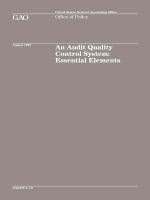Textile Testing Quality Control
Bạn đang xem bản rút gọn của tài liệu. Xem và tải ngay bản đầy đủ của tài liệu tại đây (2.63 MB, 43 trang )
Textile Testing & Quality Control Md.Azmir Latif, M.Engr.(Textile)
Page | 1
Textile Testing:
The testing of textile products is an expensive business. A laboratory has to be set up and furnished with a range
of test equipment. Trained operatives have to be employed whose salaries have to be paid throughout the year,
not just when results are required. Moreover all these costs are nonproductive and therefore add to the final cost
of the product. Therefore it is important that testing is not undertaken without adding some benefit to the final
product. There are a number of points in the production cycle where testing may be carried out to improve the
product or to prevent sub-standard merchandise progressing further in the cycle.
Reasons for Textile Testing
1. Checking Raw Materials
2. Monitoring Production
3. Assessing the Final Product
4. Investigation of Faulty Material
5. Product Development and Research
Checking Raw Materials
The production cycle as far as testing is concerned starts with the delivery of raw material. If the material is
incorrect or sub-standard then it is impossible to produce the required quality of final product. The textile
industry consists of a number of separate processes such as natural fibre production, man-made fibre extrusion,
wool scouring, yarn spinning, weaving, dyeing and finishing, knitting, garment manufacture and production of
household and technical products. These processes are very often carried out in separate establishments,
therefore what is considered to be a raw material depends on the stage in processing at which the testing takes
place. It can be either the raw fibre for a spinner, the yarn for a weaver or the finished fabric for a garment
maker. The incoming material is checked for the required properties so that unsuitable material can be rejected
or appropriate adjustments made to the production conditions. The standards that the raw material has to meet
must be set at a realistic level. If the standards are set too high then material will be rejected that is good enough
for the end use, and if they are set too low then large amounts of inferior material will go forward into
production.
Monitoring Production
Production monitoring, which involves testing samples taken from the production line, is known as quality
control. Its aim is to maintain, within known tolerances, certain specified properties of the product at the level at
which they have been set. A quality product for these purposes is defined as one whose properties meets or
exceeds the set specifications. Besides the need to carry out the tests correctly, successful monitoring of
production also requires the careful design of appropriate sampling procedures and the use of statistical analysis
to make sense of the results.
Assessing the Final Product
In this process the bulk production is examined before delivery to the customer to see if it meets the
specifications. By its nature this takes place after the material has been produced. It is therefore too late to alter
the production conditions. In some cases selected samples are tested and in other cases all the material is
checked and steps taken to rectify faults. For instance some qualities of fabric are inspected for faulty places
Textile Testing & Quality Control Md.Azmir Latif, M.Engr.(Textile)
Page | 2
which are then mended by skilled operatives; this is a normal part of the process and the material would be
dispatched as first quality.
Investigation of Faulty Material
If faulty material is discovered either at final inspection or through a customer complaint it is important that the
cause is isolated. This enables steps to be taken to eliminate faulty production in future and so provide a better
quality product. Investigations of faults can also involve the determination of which party is responsible for
faulty material in the case of a dispute between a supplier and a user, especially where processes such as
finishing have been undertaken by outside companies. Work of this nature is often contracted out to
independent laboratories who are then able to give an unbiased opinion.
Product Development and Research
In the textile industry technology is changing all the time, bringing modified materials or different methods of
production. Before any modified product reaches the market place it is necessary to test the material to check
that the properties have been improved or have not been degraded by faster production methods. In this way an
improved product or a lower-cost product with the same properties can be provided for the customer. A large
organisation will often have a separate department to carry out research and development; otherwise it is part of
the normal duties of the testing department.
Textile Testing & Quality Control (TTQC) is very important work or process in each department of export
oriented industry. Buyers want quality but not quantity. In every department of textile industry quality
maintained of each material, Because one material‘s quality depend on another‘s quality. For example, if
qualified fiber is inputted then output will be good yarn.
Testing : Testing is the process or procedure to determines the quality of a product.
Quality : The term quality refers the excellence of a product. When we say the quality of a product is good .
We mean that the product is good for the purpose for which it has been made.
Control : To check or verify and hence to regulate.
Quality Control: Quality control is the synthetic and regular control of the variable which affect the quality
of a product.
The operational techniques and activities that sustain the quality of a product or service in order to satisfy given
requirements . It consists of quality planning , data collection, data analysis and implementation and is
applicable to all phases of product life cycle ; design, manufacturing, delivery and installation, operation and
maintenance.
Objects of Quality Control:
To produce required quality product.
To fulfill the customer's demand.
To reduce the production cost.
To reduce wastage.
To earn maximum profit at minimum cost.
Textile Testing & Quality Control Md.Azmir Latif, M.Engr.(Textile)
Page | 3
Objective of Testing
Reasons for Textile Testing:
Checking the quality and suitability of raw material and selection of material.
Monitoring of production i.e. process control.
Assessment of final product, whether the quality is acceptable or not, (how will be the yarn performance in
weaving? etc).
Investigation of faulty materials (analysis of customer complaint, identification of fault in machine etc.).
Product development and research.
Specification testing: Specifications are formed and the materials are tested to prove whether they fall within the
limits allowed in the specification (e.g. specified by a customer).
Test Requirement for Export quality Textile Product
Textile Testing & Quality Control Md.Azmir Latif, M.Engr.(Textile)
Page | 4
Standard Operating Procedure(SOP)
6
Supplier submits
samples & TRF
LAB Project Team
receives and
acknowledges receipt
of sample & TRF
Sample preparation
Testing starts
Test Data available
Supervisors
verify results
Prepare Test Report
& invoice
Report issued and
sent to suppliers
10.01.2015 Corporate Presentation
Textile Testing & Quality Control Md.Azmir Latif, M.Engr.(Textile)
Page | 5
Major Chemical Test of Textile Product
Formaldehyde
Volatile compound
A gas at room temperature with a pungent smell
Readily soluble in water to form formalin or formol
Washing might reduce formaldehyde of fabrics
Release from textile at body temperature
Formaldehyde exposure can be in the form of gas –phase inhalation or liquid - phase skin absorption
Exposure to high concentration formaldehyde can be fatal; it can cause skin allergy and mucous membrane irritations.
Long term exposure may cause respiratory difficulty, eczema and sensitization
It is classed as a human carcinogen and has been linked to nasal lung cancer, and with possible links to brain cancer and
leukemia.
Nickel Release
Asthma and chronic bronchitis
Allergic reactions such as skin rashes
Heart disorders
Textile Testing & Quality Control Md.Azmir Latif, M.Engr.(Textile)
Page | 6
Hexavalent Chromium (Cr VI)
Chemical element chromium (Cr) exists in three main forms:
1. Chromium metal
2. Trivalent chromium (Cr III)
- health effect: safe
- Cr III sulfate: tanning processes
3. Hexavalent chromium (Cr VI)
- inhalation exposure: lung cancer
- direct skin contact: cause skin irritation
WHO & EPA: Cr VI is human carcinogen WHO EP
Requirement is 3 mg/kg
Phthalates
Phthalates , or phthalate esters, are esters of phthalic acid and are mainly used as plasticizers (substances
added to plastics to increase their flexibility, transparency, durability, and longevity). Phthalates are
manufactured by reacting phthalic anhydride with alcohol(s) that range from methanol and ethanol (C1/C2) up
to tridecyl alcohol (C13), either as a straight chain or with some branching. They are divided into two distinct
groups, with very different applications, toxicological properties, and classification, based on the number of
carbon atoms in their alcohol chain. They are used primarily to soften polyvinyl chloride (PVC). Lower-
molecular-weight phthalates (3-6 carbon atoms in their backbone) are being gradually replaced in many
products in the United States, Canada, and European Union over health concerns. They are replaced by high-
molecular-weight phthalates (those with more than 6 carbons in their backbone, which gives them increased
permanency and durability). In 2010, the market was still dominated by high-phthalate plasticizers; however,
due to legal provisions and growing environmental awareness and perceptions, producers are increasingly
forced to use non-phthalate plasticizers.
Phthalates are used in a wide range of common products, and are easily released into the environment. Although
there is no covalent bond between the phthalates and plastics, they are physically bound into the plastic as a
result of the heating process used to make PVC articles. They can be removed only by exposure to severe heat
or using strong solvents. However, people are exposed to phthalates, and most Americans tested by the Centers
Textile Testing & Quality Control Md.Azmir Latif, M.Engr.(Textile)
Page | 7
for Disease Control and Prevention have metabolites of multiple phthalates in their urine. Phthalate exposure
may be through direct use or by indirect means through leaching and general environmental contamination. Diet
is believed to be the main source of di(2-ethylhexyl) phthalate (DEHP) and other phthalates in the general
population. Fatty foods such as milk, butter, and meats are a major source. In studies of rodents exposed to
certain phthalates, high doses have been shown to change hormone levels and cause birth defects.
Application
As plasticizer in plastics (especially PVC)
Increase softness and flexibility
Advantage: flexibility, durability, longevity and low cost
Health effect
Bio-cumulative
Endocrine disruptor
Certain phthalates as well as their metabolites and degradation products can cause adverse effects on human
health, in particular on liver and kidney for DINP and on testicles for DEHP.
Breast cancer
However, women may be at higher risk for potential adverse health effects of phthalates due to increased cosmetic use.
Diethyl phthalate and dibutyl phthalate are especially ubiquitous in cosmetics and personal care products
Synthetic organic colorants
In theory, azo dyes can supply a complete rainbow of colours. They have fair to good fastness properties.
The azo compound class accounts for 60-70% of all dyes.
These dyes may undergo in vivo reductive cleavage to aromatic amines and some of them are proven or supposed
carcinogenic.
Application
Cotton
Wool
Polyester, Polyamide (Nylon ), Polyacrylonitrile (Synthetic fibres)
Leather
Paper
Foodstuff
Hair
Wood
Technical relevance of Azodyes
More than 3000 different azo colorants (dyes+pigments) are produced.
Textile Testing & Quality Control Md.Azmir Latif, M.Engr.(Textile)
Page | 8
Approximately 50 - 150 are banned azodyes. 50-150
- banned amine components
> 50% of the dyes used nowadays are azodyes.
Percent distribution of each chemical class between major application range
Chemical
class
Acid
Basic
Direct
Dispers
e
Mord
ent
Pigme
nt
Reac
tive
Solve
nt
Vat
Unmetalized
Azo
20
5
30
12
12
6
10
5
-
Metal complex
Azo
65
-
10
-
-
-
12
13
-
Thiazole
-
5
95
-
-
-
-
-
-
Stilbene
-
-
98
-
-
-
-
-
2
Anthraquinone
15
2
-
25
3
4
6
9
36
Indigoid
2
-
-
-
-
17
-
-
81
Quinophthalone
30
20
-
40
-
-
-
10
-
Aminoketone
11
-
-
40
8
-
3
8
30
Phthalocyanine
14
4
8
-
4
-
43
15
3
Formazan
70
-
-
-
-
-
30
-
-
Methine
-
71
-
23
-
1
-
5
-
Percent distribution of each chemical class between major application range
Chemical
class
Acid
Basi
c
Direct
Disperse
Mord
ent
Pigm
ent
Reactive
Solve
nt
Vat
Nitro,Nitro
so
31
2
-
48
2
5
-
12
-
Triarylmet
hane
35
22
1
1
24
5
-
12
-
Xanthane
33
16
-
-
9
2
2
38
-
Acridine
-
92
-
4
-
-
-
4
-
Azine
39
39
-
-
-
3
-
19
-
Oxazine
-
22
17
2
40
9
10
-
-
Thiazine
-
55
-
-
10
-
-
10
25
Textile Testing & Quality Control Md.Azmir Latif, M.Engr.(Textile)
Page | 9
Percent distribution of chemical classes in Reactive dye hue sectors/%
Chemical
class
Yello
w
Oran
ge
Red
Violet
Blue
Green
Brown
Black
% of all
reactive
dyes
Unmetaliz
ed Azo
97
90
90
63
20
16
57
42
66
Metal
complex
Azo
2
10
9
32
17
5
43
55
15
Anthraquin
one
5
34
37
3
10
Phthalocy
anine
27
42
8
Miscellane
ous
1
1
2
1
Percent distribution of chemical classes in Disperse dye hue sectors/%
10.01.2015 Corporate Presentation24
Chemical
class
Yello
w
Oran
ge
Red
Violet
Blue
Green
Brown
Black
% of all
disperse
dyes
Azo
48
92
73
47
27
30
100
100
59
Anthraquin
one
6
2
25
53
72
65
32
Nitro
16
3
3
Aminoketo
ne
8
2
1
1
5
2
Methine
14
2
Quinophth
alone
4
1
Miscellane
ous
4
1
1
1









